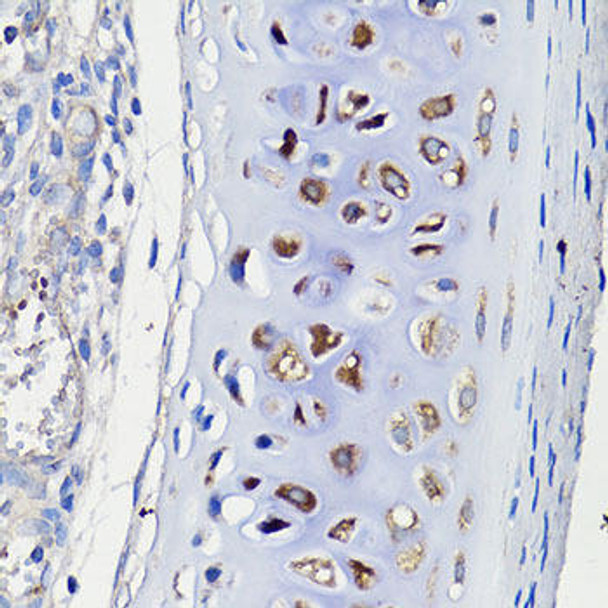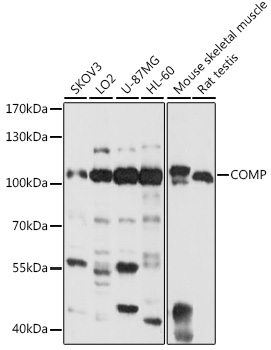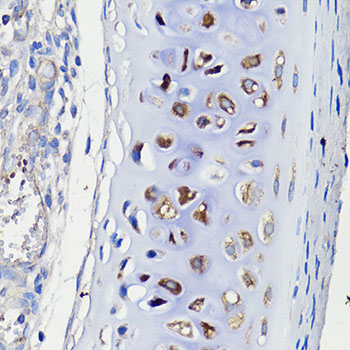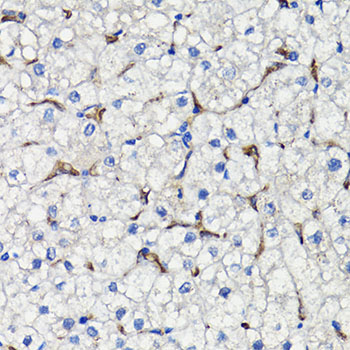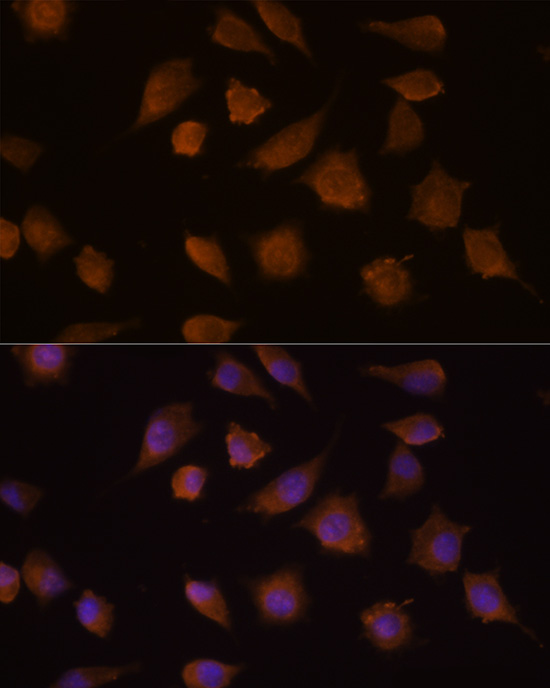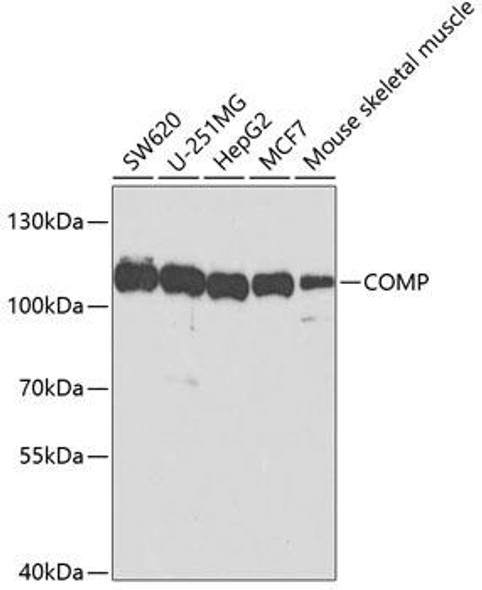Anti-COMP Antibody (CAB13963)
- SKU:
- CAB13963
- Product type:
- Antibody
- Reactivity:
- Human
- Mouse
- Rat
- Host Species:
- Rabbit
- Isotype:
- IgG
- Antibody Type:
- Polyclonal Antibody
- Research Area:
- Cell Death
Frequently bought together:
Description
| Antibody Name: | Anti-COMP Antibody |
| Antibody SKU: | CAB13963 |
| Antibody Size: | 20uL, 50uL, 100uL |
| Application: | WB IHC IF |
| Reactivity: | Human, Mouse, Rat |
| Host Species: | Rabbit |
| Immunogen: | Recombinant fusion protein containing a sequence corresponding to amino acids 20-160 of human COMP (NP_000086.2). |
| Application: | WB IHC IF |
| Recommended Dilution: | WB 1:500 - 1:2000 IHC 1:50 - 1:200 IF 1:50 - 1:200 |
| Reactivity: | Human, Mouse, Rat |
| Positive Samples: | SKOV3, LO2, U-87MG, HL-60, Mouse skeletal muscle, Rat testis |
| Immunogen: | Recombinant fusion protein containing a sequence corresponding to amino acids 20-160 of human COMP (NP_000086.2). |
| Purification Method: | Affinity purification |
| Storage Buffer: | Store at -20°C. Avoid freeze / thaw cycles. Buffer: PBS with 0.02% sodium azide, 50% glycerol, pH7.3. |
| Isotype: | IgG |
| Sequence: | GQGQ SPLG SDLG PQML RELQ ETNA ALQD VREL LRQQ VREI TFLK NTVM ECDA CGMQ QSVR TGLP SVRP LLHC APGF CFPG VACI QTES GARC GPCP AGFT GNGS HCTD VNEC NAHP CFPR VRCI NTSP GFRC EACP PGYS G |
| Gene ID: | 1311 |
| Uniprot: | P49747 |
| Cellular Location: | Secreted, extracellular matrix, extracellular space |
| Calculated MW: | 77kDa/82kDa |
| Observed MW: | 105kDa |
| Synonyms: | COMP, EDM1, EPD1, MED, PSACH, THBS5, TSP5 |
| Background: | The protein encoded by this gene is a noncollagenous extracellular matrix (ECM) protein. It consists of five identical glycoprotein subunits, each with EGF-like and calcium-binding (thrombospondin-like) domains. Oligomerization results from formation of a five-stranded coiled coil and disulfides. Binding to other ECM proteins such as collagen appears to depend on divalent cations. Contraction or expansion of a 5 aa aspartate repeat and other mutations can cause pseudochondroplasia (PSACH) and multiple epiphyseal dysplasia (MED). |
| UniProt Protein Function: | COMP: May play a role in the structural integrity of cartilage via its interaction with other extracellular matrix proteins such as the collagens and fibronectin. Can mediate the interaction of chondrocytes with the cartilage extracellular matrix through interaction with cell surface integrin receptors. Could play a role in the pathogenesis of osteoarthritis. Potent suppressor of apoptosis in both primary chondrocytes and transformed cells. Suppresses apoptosis by blocking the activation of caspase-3 and by inducing the IAP family of survival proteins (BIRC3, BIRC2, BIRC5 and XIAP). Essential for maintaining a vascular smooth muscle cells (VSMCs) contractile/differentiated phenotype under physiological and pathological stimuli. Maintains this phenotype of VSMCs by interacting with ITGA7. Defects in COMP are the cause of multiple epiphyseal dysplasia type 1 (EDM1). EDM is a generalized skeletal dysplasia associated with significant morbidity. Joint pain, joint deformity, waddling gait, and short stature are the main clinical signs and symptoms. EDM is broadly categorized into the more severe Fairbank and the milder Ribbing types. Defects in COMP are the cause of pseudoachondroplasia (PSACH). PSAC is a dominantly inherited chondrodysplasia characterized by short stature and early-onset osteoarthrosis. PSACH is more severe than EDM1 and is recognized in early childhood. Belongs to the thrombospondin family. |
| UniProt Protein Details: | Protein type:Secreted; Secreted, signal peptide Chromosomal Location of Human Ortholog: 19p13.1 Cellular Component: extracellular matrix; extracellular space; proteinaceous extracellular matrix; extracellular region Molecular Function:heparin binding; heparan sulfate proteoglycan binding; collagen binding; protein binding; protease binding; extracellular matrix structural constituent; calcium ion binding Biological Process: limb development; organ morphogenesis; extracellular matrix organization and biogenesis; apoptosis; cell adhesion; skeletal development; negative regulation of apoptosis Disease: Pseudoachondroplasia; Epiphyseal Dysplasia, Multiple, 1 |
| NCBI Summary: | The protein encoded by this gene is a noncollagenous extracellular matrix (ECM) protein. It consists of five identical glycoprotein subunits, each with EGF-like and calcium-binding (thrombospondin-like) domains. Oligomerization results from formation of a five-stranded coiled coil and disulfides. Binding to other ECM proteins such as collagen appears to depend on divalent cations. Mutations can cause the osteochondrodysplasias pseudochondroplasia (PSACH) and multiple epiphyseal dysplasia (MED). [provided by RefSeq, Jul 2008] |
| UniProt Code: | P49747 |
| NCBI GenInfo Identifier: | 209572601 |
| NCBI Gene ID: | 1311 |
| NCBI Accession: | P49747.2 |
| UniProt Secondary Accession: | P49747,O14592, Q16388, Q16389, Q2NL86, Q8N4T2, B4DKJ3 |
| UniProt Related Accession: | P49747 |
| Molecular Weight: | 77,214 Da |
| NCBI Full Name: | Cartilage oligomeric matrix protein |
| NCBI Synonym Full Names: | cartilage oligomeric matrix protein |
| NCBI Official Symbol: | COMP |
| NCBI Official Synonym Symbols: | MED; EDM1; EPD1; PSACH; THBS5 |
| NCBI Protein Information: | cartilage oligomeric matrix protein; TSP5; thrombospondin-5; pseudoachondroplasia (epiphyseal dysplasia 1, multiple); cartilage oligomeric matrix protein(pseudoachondroplasia, epiphyseal dysplasia 1, multiple); cartilage oligomeric matrix protein (pseudoachondroplasia, epiphyseal dysplasia 1, multiple) |
| UniProt Protein Name: | Cartilage oligomeric matrix protein |
| UniProt Synonym Protein Names: | Thrombospondin-5; TSP5 |
| Protein Family: | Complexin |
| UniProt Gene Name: | COMP |
| UniProt Entry Name: | COMP_HUMAN |

